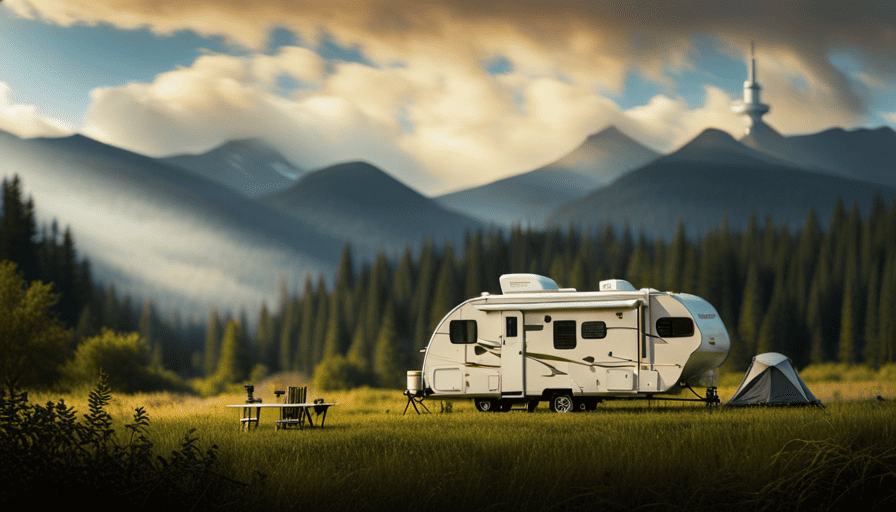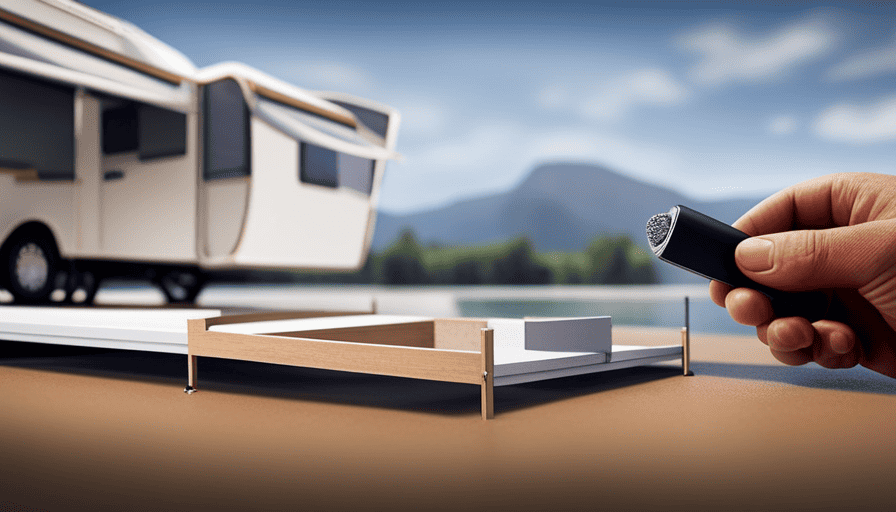Imagine this scenario: you’re cruising along the open highway, immersing yourself in the vast expanse of nature with your reliable camper van. The breeze plays with your hair, the sunlight beams down, and you’re all set for an exploration. However, what do you do when you find the power in your camper dwindling? This is when the advantage of connecting 2 batteries in your camper becomes evident.
Hi, I’m here to guide you through the process step by step, ensuring you never run out of power again. With just a few materials and some basic know-how, you can easily extend your power supply and enjoy the comforts of home on your camping trips.
From assessing your power needs to securing the batteries in place, I’ll walk you through each stage, providing technical and precise instructions.
So, let’s get started and unlock the power of your camper!
Key Takeaways
- Assess your power needs and choose the appropriate battery capacity.
- Select the right battery type for your camper (deep cycle batteries or lithium-ion batteries).
- Ensure proper ventilation and suitable placement of batteries in the camper.
- Use proper wiring techniques and battery safety precautions when connecting the batteries.
Assess Your Power Needs
Assessing your power needs is the first step in figuring out how to efficiently hook up two batteries in your camper. To ensure that you have enough power to run all the appliances and devices in your camper, you need to calculate your power usage.
Make a list of all the electrical equipment you plan to use and determine their power requirements. This will help you estimate the total power consumption.
Once you have an idea of your power needs, you can choose the appropriate battery capacity. Batteries are rated in ampere-hours (Ah), which indicates the amount of charge they can store. To determine the required battery capacity, divide your total power consumption by the voltage of your camper’s electrical system. This will give you an estimate of the minimum battery capacity you need.
Keep in mind that it’s always a good idea to have a buffer and choose a battery that has a slightly higher capacity than your calculated minimum. This ensures that you have sufficient power reserves and prevents overworking your batteries.
Now that you have assessed your power needs and chosen the right battery capacity, it’s time to gather the necessary materials for hooking up the batteries in your camper.
Gather the Necessary Materials
Preparing for your camper adventure? Well, it’s time to gather all the stuff you’ll need to make your battery connection dreams come true!
The first step is choosing the right battery type for your camper. There are various options available, such as deep cycle batteries or lithium-ion batteries. Deep cycle batteries are designed to provide a steady amount of power over a long period of time, making them ideal for campers. On the other hand, lithium-ion batteries are lightweight, have a longer lifespan, and can provide more power, but they’re also more expensive.
Once you’ve chosen the battery type, it’s crucial to ensure proper ventilation. Batteries emit gases during the charging process, and if not properly ventilated, these gases can be harmful. Make sure to install your batteries in a well-ventilated area to prevent any potential hazards. This can be achieved by placing them in a battery box with vent holes or locating them in a compartment with proper ventilation.
Now that you’ve gathered the necessary materials and chosen the right battery type while ensuring proper ventilation, it’s time to determine the battery placement. This step will involve finding the most suitable location in your camper to install the batteries.
Determine the Battery Placement
Find the perfect spot in your camper to position the batteries for optimal functionality and convenience. When choosing the right batteries for your camper, it is crucial to consider their capacity and voltage. Deep cycle batteries are often recommended due to their ability to provide a steady amount of power over a long period. Additionally, ensure that the batteries are compatible with your camper’s electrical system.
Proper ventilation for battery placement is essential to prevent overheating and prolong the lifespan of the batteries. Keep in mind that batteries generate gases during charging, so it is crucial to place them in a well-ventilated area. Avoid locating the batteries near heat sources or in direct sunlight, as this can lead to excessive heat buildup and potential damage to the batteries.
To aid in your decision-making process, consider the following factors when determining the battery placement:
| Factor | Consideration |
|---|---|
| Weight Distribution | Position the batteries to maintain proper weight distribution. |
| Accessibility | Ensure easy access for maintenance and replacement. |
| Wiring Considerations | Plan the battery placement to minimize wire length. |
| Safety | Keep the batteries away from flammable materials. |
By carefully considering these factors, you can determine the ideal placement for your batteries. With the battery placement finalized, you can now move on to the next step of connecting the positive terminals.
Connect the Positive Terminals
Once you’ve determined the perfect spot for your batteries, it’s time to connect the positive terminals and bring the power to life, like completing the circuit that illuminates your camper with energy. Proper wiring techniques are crucial to ensure a successful connection.
Start by preparing the positive terminals of both batteries. Remove any corrosion or debris using a wire brush and make sure the terminals are clean and shiny.
Next, connect the positive terminal of the first battery to the positive terminal of the second battery using a battery cable. It’s important to use the appropriate gauge cable to handle the current flow. Secure the connection by tightening the terminal nuts with a wrench.
After connecting the positive terminals, it’s important to verify that the connection is secure and there are no loose connections or exposed wires. This will help prevent any electrical issues or potential damage to your camper’s electrical system. Troubleshooting tips include checking for proper insulation, ensuring the terminals aren’t touching any metal surfaces, and double-checking the cable connections.
Once you have successfully connected the positive terminals, you’re ready to move on to connecting the negative terminals, which will complete the circuit and provide power to your camper.
Connect the Negative Terminals
To complete the circuit and ensure a seamless flow of power, you should connect the negative terminals of your batteries. Proper grounding is essential when hooking up multiple batteries in a camper. Here are a few important points to consider:
-
Use a heavy gauge wire: It’s crucial to use a heavy gauge wire, such as a 4-gauge wire, to connect the negative terminals. This ensures that the wire can handle the high current flow without overheating.
-
Clean the terminals: Before connecting the negative terminals, make sure to clean them thoroughly. This helps to establish a good electrical connection and reduces the chances of corrosion.
-
Follow battery safety precautions: Always wear protective gloves and safety glasses when working with batteries. This protects you from any potential acid spills or electrical hazards.
-
Use a battery terminal connector: To secure the connection between the negative terminals, consider using a battery terminal connector. This provides a strong and reliable connection.
-
Double-check the polarity: Before finalizing the connection, double-check the polarity of the batteries. The negative terminals should be connected to each other, while the positive terminals should be connected to each other.
Now that the negative terminals are properly connected, it’s time to move on to the next step: installing the battery isolator or selector switch.
Install the Battery Isolator or Selector Switch
Now that you’ve securely connected the negative terminals, it’s time to install the battery isolator or selector switch for optimal power distribution in your camper. The battery isolator or selector switch allows you to choose between using one battery, the other battery, or both batteries simultaneously. This ensures that power is evenly distributed and prevents one battery from draining the other.
When it comes to wiring options, there are a few different ways to connect the batteries. The most common options include parallel, series, and dual battery systems. In a parallel system, the positive terminals of both batteries are connected together, as well as the negative terminals. This allows the batteries to work together as one unit, increasing the overall capacity. In a series system, the positive terminal of one battery is connected to the negative terminal of the other battery. This increases the voltage while keeping the capacity the same. Lastly, a dual battery system uses a battery isolator or selector switch to control the power distribution between the batteries.
Troubleshooting tips for your battery setup include checking the connections for loose or corroded wires, ensuring the battery isolator or selector switch is functioning properly, and testing the voltage output of each battery. If you encounter any issues, refer to the manufacturer’s instructions or consult a professional.
Now that the battery isolator or selector switch is installed, it’s time to test the connection and ensure everything is functioning as intended.
Test the Connection
Check if your power distribution system is working smoothly by testing the connection between your battery isolator or selector switch and the batteries – can you feel the excitement of finally having a reliable source of power for your camper? Testing the connection is an essential step to ensure that everything is properly set up and functioning correctly.
There are a few testing methods you can use to confirm the connection. First, you can use a voltmeter to measure the voltage across the battery terminals. Connect the positive lead of the voltmeter to the positive terminal of one battery and the negative lead to the negative terminal of the other battery. A reading close to the combined voltage of the two batteries indicates a successful connection.
If you encounter any issues during the testing process, there are some troubleshooting tips you can follow. Double-check all the connections, ensuring they’re secure and tight. Look for any loose or corroded terminals that may be causing poor conductivity. Additionally, inspect the wiring for any signs of damage or fraying.
Once you’ve tested the connection and everything’s working smoothly, you can move on to securing the batteries in place. This ensures that they stay in position and don’t shift while you’re on the road.
Secure the Batteries in Place
Make sure your batteries are securely fastened in place to prevent any movement while you’re traveling in your camper. Properly securing the batteries is crucial for their safety and longevity.
There are several battery mounting options available, depending on the size and type of batteries you have. One option is to use battery boxes, which provide a protective enclosure for the batteries and prevent them from shifting during travel. Another option is to use battery hold-down straps, which securely fasten the batteries to the camper’s frame or floor.
When securing the batteries, it’s important to follow some safety precautions. Make sure the batteries are positioned in a well-ventilated area to prevent the buildup of harmful gases. Additionally, ensure that the connections between the batteries and the camper’s electrical system are properly insulated to avoid any short circuits or electrical hazards.
By securely fastening your batteries in place, you can ensure their stability and reduce the risk of damage while on the road.
In the next section, we will discuss how to monitor and maintain the batteries to keep them in optimal condition for your camper’s electrical needs.
Monitor and Maintain the Batteries
Ensure that you regularly monitor and maintain the condition of your camper’s batteries to guarantee optimal performance and longevity. To extend battery life, there are a few key steps you can take.
First, it’s important to keep the batteries clean and free of corrosion. Regularly inspect the terminals and clean them with a mixture of baking soda and water if necessary.
Additionally, check the water levels in your batteries regularly, especially if they’re of the flooded lead-acid type. Add distilled water as needed to keep the cells properly filled.
Troubleshooting common battery issues is also crucial. If you notice that your batteries aren’t holding a charge or are experiencing a decrease in performance, it could be a sign of sulfation. This occurs when lead sulfate crystals build up on the battery plates and hinder the charging process.
To combat this, you can use a desulfator or battery conditioner to break down these crystals and restore battery efficiency.
Monitoring and maintaining your camper’s batteries is essential to ensure they perform optimally and last longer. By following these tips on how to extend battery life and troubleshooting common issues, you can enjoy your extended power supply without any interruptions.
Enjoy Your Extended Power Supply
Now that we’ve learned how to monitor and maintain the batteries in our camper, let’s move on to the exciting part – enjoying our extended power supply! With the ability to hook up 2 batteries, we can now maximize our battery life and have the freedom to stay off-grid for longer periods.
To fully enjoy our extended power supply, here are three important things to keep in mind:
-
Efficient Power Usage: To make the most of our batteries, it’s crucial to be mindful of our power consumption. We should prioritize energy-efficient appliances and gadgets, turn off lights when not in use, and avoid leaving devices on standby mode.
-
Regular Inspections: It’s essential to regularly inspect our battery connections, ensuring they’re secure and free from corrosion. Loose connections and corrosion can lead to power loss and inefficient charging.
-
Troubleshooting Common Issues: Despite our best efforts, we may encounter common issues with our batteries. It’s important to have a basic understanding of troubleshooting techniques, such as checking fuses, testing voltage levels, and identifying potential wiring problems.
By following these guidelines, we can make the most of our extended power supply while on the road, ensuring a smooth and uninterrupted camping experience.
Frequently Asked Questions
How do I determine my power needs for my camper?
Determining power needs for a camper involves calculating energy consumption. To start, make a list of all electrical appliances you plan to use and their power requirements.
Determine the number of hours each device will be used daily. Multiply the power requirement by the hours of usage to get the energy consumption per day.
Sum up the energy consumption of all devices to get your total power needs. This will help you choose the right battery setup for your camper.
What materials do I need to gather in order to hook up two batteries in my camper?
To determine battery capacity, I must consider my power needs and the duration I want the batteries to last. This will help me choose the right size batteries.
When it comes to wiring, I need to select the appropriate gauge based on the distance between the batteries and the camper’s electrical system. It’s crucial to use the correct wiring size to avoid voltage drop and ensure efficient power flow.
How do I decide on the placement of the batteries in my camper?
When considering camper battery placement, it’s crucial to prioritize battery hookup efficiency. To determine the ideal location for your batteries, assess factors such as weight distribution, accessibility, and ventilation.
Placing them near the camper’s center of gravity ensures better stability during travel. Additionally, ensure easy access for maintenance and monitoring. Adequate ventilation is vital to prevent overheating.
By carefully considering these factors, you can optimize battery performance and ensure a reliable power supply for your camper.
Can you explain how to connect the positive terminals of the batteries in detail?
To connect the positive terminals of two batteries, you’ll need battery wiring. Here’s how to do it:
- Start by ensuring both batteries are the same voltage and type.nn2. Connect the positive terminal of one battery to the positive terminal of the other using a battery cable.nn3. Make sure the connection is tight and secure.nn4. This will create a parallel connection, where the positive terminals are joined together, increasing the overall capacity of the battery system.
What steps should I take to monitor and maintain the batteries in my camper?
To ensure optimal performance and longevity of the batteries in your camper, there are a few battery maintenance tips you should follow.
Firstly, regularly check the battery’s water levels and top up if necessary.
Secondly, clean the battery terminals and connections to prevent corrosion.
Additionally, consider installing a battery monitoring system to keep track of voltage levels and prevent overcharging.
Following these steps will help you maintain and monitor your camper’s batteries effectively.
Conclusion
After following the steps outlined in this article, I successfully hooked up two batteries in my camper. I assessed my power needs and gathered the necessary materials. This allowed me to determine the best placement for the batteries and connect the positive and negative terminals. Next, I made sure to follow the camper hookup steps precisely to ensure a safe and reliable connection. I carefully tested the batteries to make sure they were functioning properly before using them to power my camper. By following these steps, I was able to have peace of mind knowing that my power supply would meet my needs during my camping trips.
Testing the connection and securing the batteries in place ensured a reliable power supply. Lastly, monitoring and maintaining the batteries will ensure their longevity. With this extended power supply, I can now enjoy my camper adventures without worrying about running out of power.










